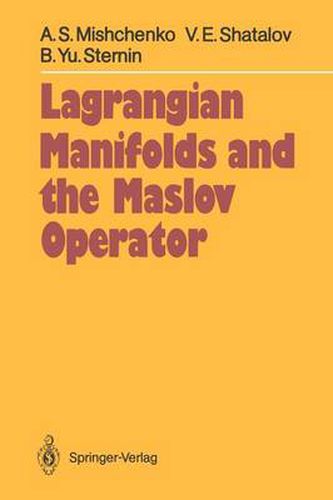Readings Newsletter
Become a Readings Member to make your shopping experience even easier.
Sign in or sign up for free!
You’re not far away from qualifying for FREE standard shipping within Australia
You’ve qualified for FREE standard shipping within Australia
The cart is loading…






This title is printed to order. This book may have been self-published. If so, we cannot guarantee the quality of the content. In the main most books will have gone through the editing process however some may not. We therefore suggest that you be aware of this before ordering this book. If in doubt check either the author or publisher’s details as we are unable to accept any returns unless they are faulty. Please contact us if you have any questions.
This book presents Maslov’s canonical operator method for finding asymptotic solutions of pseudo differential equations. The classical WKB method, so named in honor of its authors: Wentzel, Kramers and Brillouin, was created for finding quasi classical approximations in quantum mechanics. The simplicity, obviousness and physicalness of this method quickly made it popular: specialists in mathematical physics accepted it unequivocally as one of the weapons in their arsenal. The number of publications which are connected with the WKB method in one way or another can probably no longer be counted. The alternative name of the WKB method in diffraction problem- the ray method or the method of geometric optics - indicates that the approximations in the WKB method are constructed by means of rays. More precisely, the first approximation of the WKB method is constructed by means of rays (isolating the singular part), after which the usual methods of the (regular) theory of perturbations are applied. However, the ray method is not applicable at the points of space where the rays focus or form a caustic. Mathematically this fact expresses itself in the fact that the amplitude of the waves at such points become infinite.
$9.00 standard shipping within Australia
FREE standard shipping within Australia for orders over $100.00
Express & International shipping calculated at checkout
This title is printed to order. This book may have been self-published. If so, we cannot guarantee the quality of the content. In the main most books will have gone through the editing process however some may not. We therefore suggest that you be aware of this before ordering this book. If in doubt check either the author or publisher’s details as we are unable to accept any returns unless they are faulty. Please contact us if you have any questions.
This book presents Maslov’s canonical operator method for finding asymptotic solutions of pseudo differential equations. The classical WKB method, so named in honor of its authors: Wentzel, Kramers and Brillouin, was created for finding quasi classical approximations in quantum mechanics. The simplicity, obviousness and physicalness of this method quickly made it popular: specialists in mathematical physics accepted it unequivocally as one of the weapons in their arsenal. The number of publications which are connected with the WKB method in one way or another can probably no longer be counted. The alternative name of the WKB method in diffraction problem- the ray method or the method of geometric optics - indicates that the approximations in the WKB method are constructed by means of rays. More precisely, the first approximation of the WKB method is constructed by means of rays (isolating the singular part), after which the usual methods of the (regular) theory of perturbations are applied. However, the ray method is not applicable at the points of space where the rays focus or form a caustic. Mathematically this fact expresses itself in the fact that the amplitude of the waves at such points become infinite.